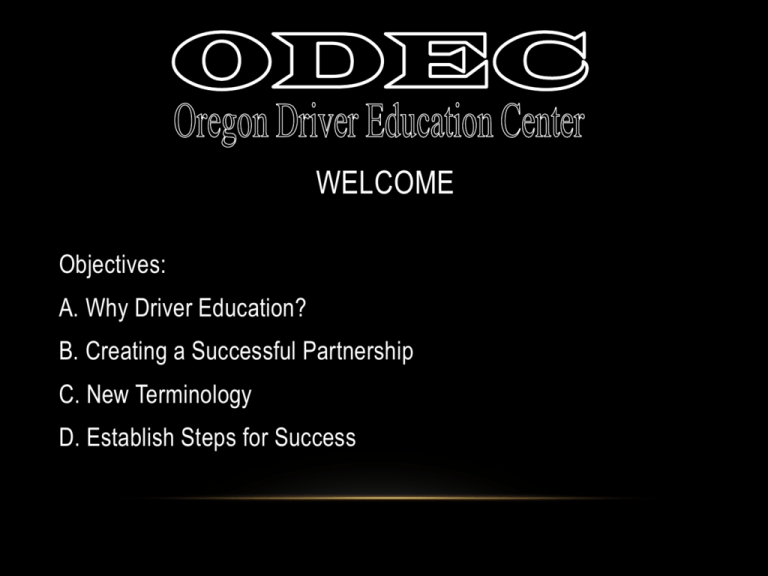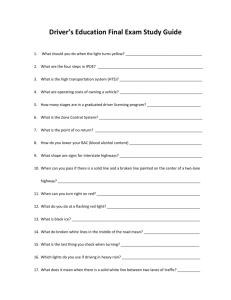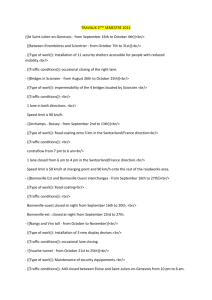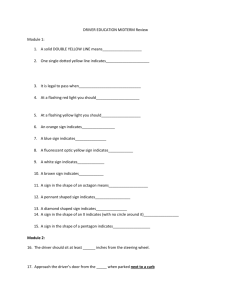What is a LOS - Oregon Driver Education Center
advertisement

WELCOME Objectives: A. Why Driver Education? B. Creating a Successful Partnership C. New Terminology D. Establish Steps for Success AT THE END OF THE DAY. . . It’s about getting home safely! THE BAD NEWS Automobile crashes are the #1 cause of death for teens in Oregon. More than 600 were involved in fatal & injury collisions in 2006. MOST DANGEROUS TIMES FOR TEEN DRIVERS 16 14 12 10 8 6 4 2 0 DEADLIEST DAYS OF THE WEEK 16 & 17 YEAR OLD FATALITIES IN 2005 THE GOOD NEWS A national study (NHTSA, 2005) completed in Oregon revealed that teens taking formal driver education are. . . • 11-21% less likely to be in a collision, • 39-57% less likely to have a traffic conviction, • 51-53% less likely to have their license suspended. YOU’VE MADE THE RIGHT DECISION Teenagers taught to drive by both professionals and their parents are nearly three times less likely to be involved in serious accidents than those who do not receive professional training. -NHTSA (2007) OREGON 16 YEAR OLD FATAL & INJURY CRASHES DOWN 55% WHAT CAUSED THE DROP IN DEATH AND INJURY CRASHES? Oregon’s Graduated Driver’s License Program took effect in 1998. Fatal and injury crashes for 16 and 17 year have dropped dramatically ever since. GOOD REASON FOR THE RULES • With one teen passenger, the average new driver is TWICE as likely to be involved in a crash. • With two teen passengers, the average new driver is THREE times as likely to crash. • With three teen passengers, the average new driver is FOUR times as likely to crash. LET’S PUT THAT ANOTHER WAY… PARENTS: Do you want your Son/Daughter To be an driver THEN SOMETHING DIFFERENT MUST OCCUR IN THEIR LEARNING EXPERIENCE THE SOLUTION Good Habit Development It requires a successful Partnership between… Teacher, Student and Parents Students need GUIDED PRACTICE to form good Driving Habits WE ALL KNOW ABOUT PRACTICEBut what is GUIDED PRACTICE? Do you remember learning how to type? WHAT IS GUIDED PRACTICE? Let’s try it together: Using an imaginary keyboard, close your eyes and and type the word the COULD YOU DO IT? Could you see the keyboard in your mind? Which fingers did you use? If you could “see” the keyboard in your mind, and type the letters, it’s because you learned to type through guided practice. Your teacher taught you where to place your fingers on the keyboard and where each letter was located. Then you practiced until you could successfully type anything you wanted. You built good habits! GUIDED PRACTICE PRINCIPLES • It is provided by a Parent/Coach. • Supervised practice of specific maneuvers on a prescribed route. It supplements what the student has learned in class and the in-car sessions. • You can plan your lessons with the Oregon Parent Guide to Teen Driving • Your attitudes and values have the greatest influence upon your teen towards safe driving practices. • Parents need to provide their teen with five hours of guided practice during the driver education course. “LEARNING” OCCURS WHEN BEHAVIOR IS CHANGED How do we change behavior and learn good habits? HABIT DEVELOPMENT Knowledge: What to do Skill: How to do it Attitude: Desire or want to do it K+S+A = Habit Pattern of Behavior Can Be Learned or unlearned Requires Time, Energy and Commitment S K H A THE LEARNING PROGRESSION 4th - Unconsciously Competent (This is the goal! Habitually correct behavior.) 3rd - Consciously Competent (Lots of practice to reach this point, but still have more to learn.) Stage 4 can only be achieved guided 2 - through Consciously Incompetent (We understand the task, but are practice. not but are not very good at it.) nd 1st - Unconsciously Incompetent (We have no idea how to perform a task.) HOW MANY TIMES MUST YOU REPEAT A BEHAVIOR BEFORE IT BECOMES A HABIT? • 8 Times = long term memory • 28 times = unconscious memory (habit) Conclusion: Students don’t drive the way they were taught because they don’t do the correct behavior enough times for it to become habitual. 10 Model Driving Habits Form the Basis of the Driver Education Course 1. Get Driver-Vehicle Readiness 2. See a clear path before moving 3. Keep the car in balance 4. Use reference points 5. Do LOS-POT searching 6. Turn decisions into actions 7. Control the intersection 8. Get rear zone control 9. Get control with a vehicle in front 10.Be courteous to others US CRASH PYRAMID Deaths 42,600 Disabled 200,000 Injuries 2,799,000 Minor Crashes Close Calls Stressful Situations High Risk Driver Behaviors Estimated 9 X 10 ²³ “Not Everything That Counts Can Be Counted” - Albert Einstein The statistics on the previous slide are the best reason for each of us to commit to spending as much time as necessary to teach our youngest drivers the skills and habits they need to be safe. We should feel some outrage to know that more than 42,000 Americans die on our roads each year. And we should be dismayed to know that nearly 3 million of us are injured in crashes each year. ParentsDid you take Driver Education? Do you think anything has changed? What color is a yield sign? Don’t feel too bad. It used to be yellow It changed about 15 years ago. What will your student learn? Vision vs. Perception Response vs. Reaction Lane Position Pull-Push Steering Technique Following Distance Reference Points Zone Control and so much more! VISION VS. PERCEPTION Take the following test. Read the following sentence through once and count the number of f’s. FINISHED FILES ARE THE RESULT OF YEARS OF SCIENTIFIC STUDY COMBINED WITH YEARS OF EXPERIENCE. How many letter F’s did you see? 3? 4? 5? 6? More? FINISHED FILES ARE THE RESULT OF YEARS OF SCIENTIFIC STUDY COMBINED WITH YEARS OF EXPERIENCE. How did you do? There were 6 letter f’s in the sentence. Would you have done better if you had known you were looking for 6 of them? This illustrates the difference between vision and perception. Perception involves seeing as well as understanding what to look for and how to interpret the information we gather. Proper Perception is vital to good driving! Changes That May Surprise You! • Hand Position: 3 & 9 or 4 & 8 • Braking technique: Squeeze; don’t pump • Mirror Adjustment: Enhanced Setting • Headlights On: Night and DAY! • Steering Technique: Pull/Push vs. hand over hand • Sign changes • Legal Stop position • Graduated Driver’s Licensing MIRROR ADJUSTMENT Traditional view Enhanced method Adjusting the Side Mirrors The next slide shows the blind spot created by the traditional mirror adjustment, which involves a large overlap in what is seen in the three mirrors. Notice that the blind spot with this mirror setting is big enough to easily hide a full-sized vehicle from the view created by the side mirror. Cones outline the blind areas caused by traditional mirror settings Traditional side view mirror settings shows same view as rear view mirror TRADITIONAL SETTING RIGHT BLIND SPOT RIGHT SIDE VIEW REAR MIRROR LEFT SIDE VIEW TRADITIONAL SETTING LEFT BLIND SPOT VIEW Blind Spot—Glare Elimination The enhanced mirror adjustment is pictured on the following slide. While this setting doesn’t eliminate the need for over the shoulder checks, as you can see, this setting does make the side blind spot much, much smaller. All you need to do to achieve the enhanced setting is tilt the mirrors out about 12 degrees so that the side of your vehicle is not visible when you look in the mirrors. The BGE enhanced side mirror settings (15 degrees to outside) minimizes right and left side mirror blind areas ENHANCED RIGHT SIDE MIRROR VIEW REAR MIRROR VIEW ENHANCED LEFT SIDE MIRROR VIEW LANE POSITION Space management is an important aspect of driver’s education. Managing the space in our lane of traffic is particularly important. To make it easy to talk about the space within our lane, numbers are assigned to each area. These lane positions allow students to learn to effectively use each part of their lane to improve their line of sight and establish the best separation from other vehicles or obstacles. Lane Position Options 4 2 1 3 5 Lane position 4 and 5: Straddling the line to avoid a problem MAKING LANE CHANGES Because making lane changes is a potentially troublesome maneuver for most new drivers, we work on a procedure they can use to be sure they are making a safe movement from one lane to another. We use the acronym MSMOG to help them remember where to look and what to look for as they prepare for lane changes. LANE CHANGE ACRONYM Mirror-(Rear View) Signal Mirror-(Side View) Over-the-Shoulder Go MORE LANE CHANGE CONSIDERATIONS Once the students understand how to use MSMOG to be sure it’s safe to change lanes, they are taught to steer smoothly through the lane changes by referring to the lane positions. CONTROL YOUR TRACKING PATH 1 Maintain Your Speed Move to new lane 3 Cancel Signal Evaluate Front & Rear Zone Conditions 4 Get Best Lane Position 2 STEERING TECHNIQUES You were probably taught to hold the steering wheel at the 10 & 2 positions. But chances are you learned to drive on a vehicle that did not have air bags. And you probably used a hand over hand technique to steer into turns. But your students will be taught pull-push steering. They will hold the wheel at 8 & 4 or at 9 & 3, and learn to turn without crossing their hands—a safer form of steering air-bag equipped vehicles. PULL/PUSH (HAND TO HAND) STEERING PULL-PUSH ADVANTAGES •Pull-push steering gives better steering control. •The driver keeps both hands on the wheel at all times. •The left and right hands never cross to the opposite side of the wheel, minimizing risk of injury due to air bag deployment. Turning with Pull-Push Steering 11 1 •Right Turn •Right Turn •Left Hand Push Up •Right Hand Pull Down 7 5 A right turn is initiated by pulling the wheel down from 1 o’clock to five o’clock, while the left hand glides down to 7 o’clock. At that point, the left hand goes to work, pushing the wheel up to 11 o’clock, while the right hand glides up to one o’clock to meet it and so on. WHAT IS A LOS – POT? Learning some new vocabulary will be part of your student’s experience, too. LINE OF SIGHT: Anything that blocks our ability to gather critical information. PATH OF TRAVEL: Anything that blocks our ability to occupy a space in the road. How is your LOS (Line of Sight)? What is the Potential Problem? You have a line of sight blockage caused by the building. It could be hiding pedestrians on the sidewalk. WHERE SHOULD YOU STOP? Students will learn how to make correct, complete Legal Stops. They will practice making Safety Stops to improve their line of sight. And they will learn the advantages of the Staggered Stop and when to use it. LEGAL STOP BEFORE STOP LINE, CROSSWALK, PEDESTRIAN ZONE SAFETY STOP FRONT EVEN WITH THE CURB LINE. MOVE TO THIS POSITION AFTER THE LEGAL STOP TO IMPROVE YOUR LINE OF SIGHT. Remember: This position is IN ADDITION to a Legal Stop! STAGGERED STOP SEE STOP LINE 15 FEET AHEAD REFERENCE POINTS Students quickly find that the body of the vehicle causes a large blind area that makes the car seem to be much larger than it really is. We introduce the concept of reference points to help them overcome the problem. Where is the front bumper in relationship to the white line? You can line up the side view mirror with the curb line. Students learn a series of reference points that will help them place their vehicle precisely. The best part is that the reference points work on all vehicles. KEEPING THE CAR IN BALANCE Show me what it feels like… when a driver slams on the brake. when a driver takes off too fast. when a driver makes a turn too fast or a lane change too sharply. These “feelings” should be seen as a RED FLAG that a high risk behavior is occurring. VEHICLE BALANCE TERMS USED Pitch – Vehicle weight is transferred to the front or the rear tires when braking or accelerating. Loss of traction can occur. Roll - Vehicle weight is transferred to the side tires when turning or cornering. Loss of traction can occur. Yaw – Traction to tires is lost causing vehicle to spin around its center of gravity or “Yaw” axis. THE ZONE CONTROL SYSTEM This is the framework for using the 10 Driving Habits in every situation. • FIND – Identify a LOS-POT change. • SOLVE – Check other zones and get necessary information to make a decision. • CONTROL – Applying the best SPEED control, best LANE POSITION and best COMMUNICATION. STEPS FOR SUCCESS • Guided practice between BTW drives • Communicate with instructors • Have a Parent Teen Contract • Establish your families boundaries GOALS FOR NEW DRIVERS PARENTS WANT: TEENS WANT: • Child’s safety • Wheels • Protection of investment • Action • Respect for authority • Peer Acceptance • Respect for others • Freedom COURSE REQUIREMENTS Eligibility To qualify for State Certification a student must complete 30 hrs of classroom instruction and 12 hrs of BTW instruction before obtaining their driver license and or their 18th birthday. An additional $210 will be charged for students who do not meet these guidelines. Behind-the-Wheel (BTW) BTW lessons occur outside of class time. Parents can begin scheduling the 6 lessons after the first day of class. Each lesson is 2hrs long. 1 hour the student drives and 1 hour they observe. There is a late cancelation fee for canceling a lesson with less than 72hr notice. Classroom Students are required to be in class for 30hrs and receive an 80% or higher to complete. Any class time missed must be made up prior to course completion. We have several location to make up hours missed hours CLASSROOM There are 3 exit exams taken online at home. If a student gets 90% or better on each exit exam they bypass the written final. Student still has to show up for class because they have to be in class for 30 hours. TRUE OR FALSE? Driver Ed will allow students to bypass the DMV drive test. True!! LICENSE REQUIREMENTS • Still Need to have 50 hours of driving • Still have to take the knowledge test from DMV • Still have to have their permit for 6 months • Still has to be 16 years old A PARENT-TEEN AGREEMENT CAN BRING YOU TOGETHER Formal contract Must be clear Must be enforced ESTABLISH FAMILY BOUNDARIES The Graduated Drivers License creates a few boundaries for the new licensed driver. You may want to consider these boundaries for your own teen: Set Driving Area Limits 80% of fatal collisions in Oregon occur on rural roads. Restrict Night Driving Most teen nighttime fatal crashes occur from 9pm to 12 am Restrict their passengers Tighten or further extent law already in place Reduce Distractions Have guidelines for loud music, etc. Being a passenger Know who your teen is driving with. Are they responsible? REMEMBER: YOU’RE THEIR ROLE MODEL! New Drivers learn a lot by example, so be sure that you practice safe driving habits. Teens with crashes and violations often have role models with poor driving records. CHOOSE VEHICLES FOR SAFETY, NOT IMAGE. Teenagers should drive vehicles that reduce their chances of a crash and offer protection in case they do crash. • • • • Small Cars don’t offer the best protection in a crash. Airbags save lives. Avoid cars with performance images, they encourage speeding. Avoid trucks and sport utility vehicles – they are more prone to roll over. Research vehicle crash test ratings at: http://www.hwysafety.org/vehicle_ratings/ratings.htm BY WORKING AS A TEAM— STUDENT, PARENTS AND TEACHERS We can all get home safely!




